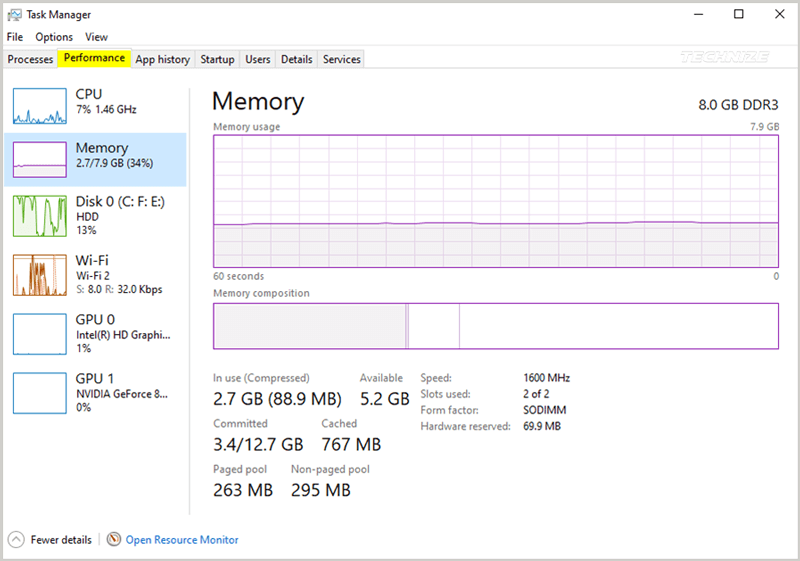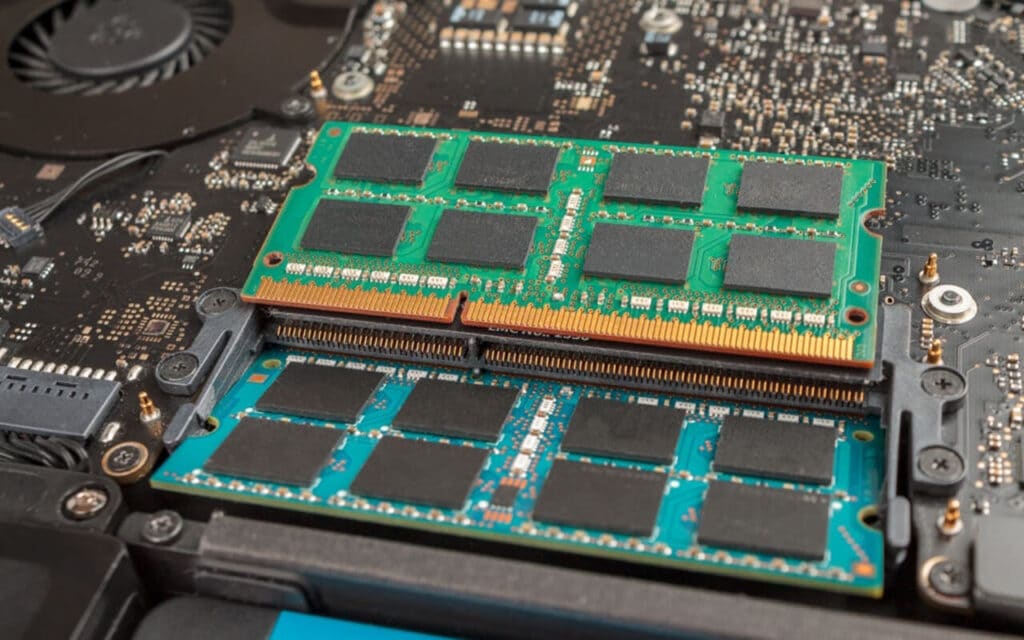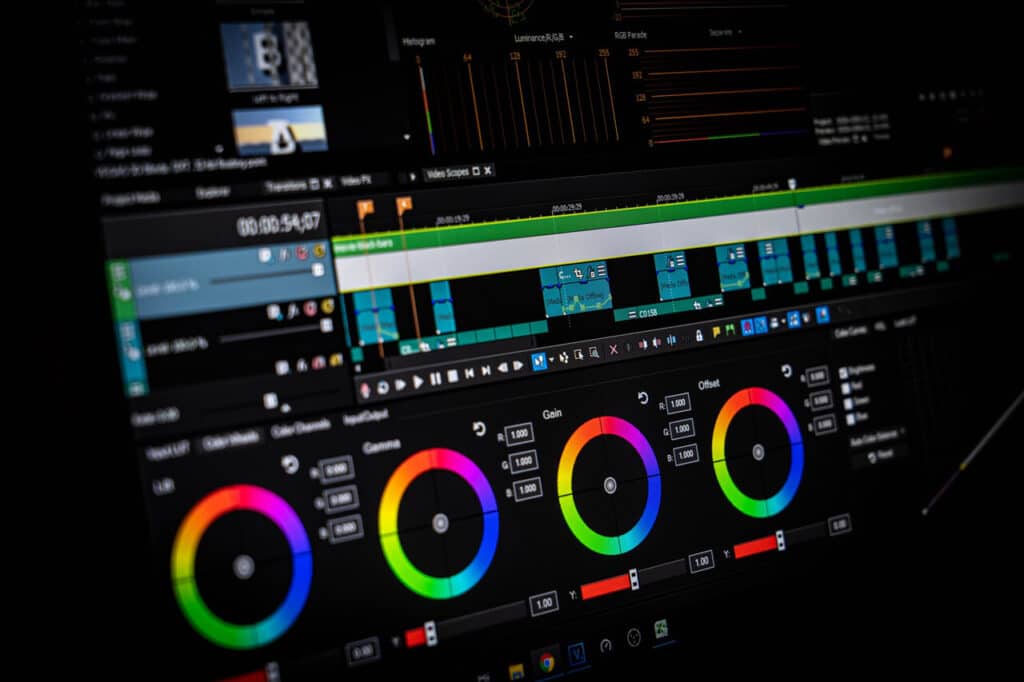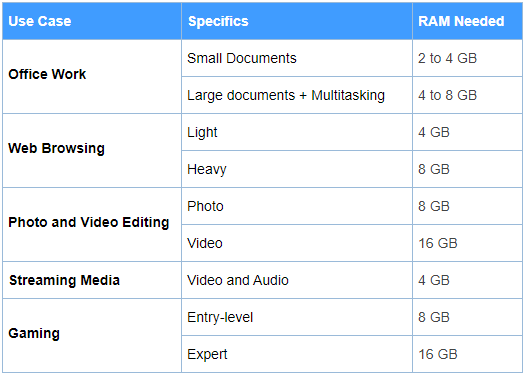I recently powered on my laptop and noticed that it took slightly longer to load the desktop icons. So I deployed the Ctrl+Alt+Delete to find out which process was causing this on the task manager.
Only background processes were running, which I always prefer not to interfere with. So I clicked on the Performance tab to check how much RAM was currently in use. I was surprised to find out that, without running any processes, my laptop was using a whopping 2.7GB out of the total 8GB installed.

This led me to the question, is 8GB no longer enough? How much RAM do I really need in a laptop?
I will be using the terms RAM and memory interchangeably to mean the same thing.
Table of Contents
What is RAM?
Random Access Memory (RAM) is the computer’s temporary storage where files needed for an application to run are stored and availed for use. Having enough RAM is essential for your laptop’s performance.
Programs like Netflix, VLC, Adobe, etc., will not run on your laptop without RAM. RAM is called temporary storage because once you close a program, the files required for that program to run are automatically deleted.
The same happens when you shut down your laptop. Contrary to this is permanent storage on hard disk drives (HDD) and solid-state drives (SSD). RAM is highly dynamic; data is constantly being written, deleted, and re-written. For example, suppose the files needed to run programs were stored in permanent storage (SSD and HDD); it would take ages to fetch the files, slowing down the running program.

You can think of RAM this way. Say you have an important speech to give off the head or a presentation. You don’t want to read out a pre-written one. So how do you remember the main points? First, you write some keywords on your wrist. Then, when you’re done with the speech/presentation, you don’t need these notes on your wrist, so you wash them off. Here your wrist functions similarly to the way RAM does for your laptop.
Prices pulled from the Amazon Product Advertising API on:
Product prices and availability are accurate as of the date/time indicated and are subject to change. Any price and availability information displayed on [relevant Amazon Site(s), as applicable] at the time of purchase will apply to the purchase of this product.
How Much RAM do You Actually Need on Your Laptop
There is no specific answer for this. It always comes back to what you intend to do with your laptop. Some processes require more RAM than others. There are minimum requirements outlined for these different processes. Having more RAM in your laptop is always a good thing, but more RAM is useless and adds nothing to your laptop’s performance beyond a certain capacity. Here we’re going to divide what you might want into five categories and outline the minimum and most convenient RAM you need for them.
Office Work
Creating and editing documents on Microsoft Word, for example, requires less RAM. So, if that is the task you’re running on your laptop, 2GB RAM should be able to get you over. But, what are the odds that this is the only thing you do at the office? Close to zero. Remember, when you power your laptop on, there are background processes and Windows processes using RAM. So, a 2GB RAM laptop can’t get you anywhere with the current state of technology.

4GB RAM should comfortably be able to support the creation and editing of documents alongside other tasks. Office work gets more demanding when you’re multi-tasking on your laptop. In addition, the more programs you open, the more RAM is used. So if you’re working with smaller size documents (less than 1000 words), 4GB RAM should be able to get you over the line even when several of them are open.
Most people who purpose their laptops for office work don’t think they should go over 4GB RAM. However, if your job involves working with large documents (1000 words +) and or heavy multitasking (more than 20 files or 5 programs), 4GB RAM will not be able to handle this. You need a minimum of 8GB to get you through these high-resource processes. If your job involves data engineering or software development, aim for 8GB or higher. Although I know you already know this.
Web Browsing
Google’s Chrome is the most popular web browser out there. Unfortunately, it also has a bad reputation for consuming a lot of RAM. You can just open multiple tabs on Chrome, go to task manager, and check how much memory it uses. 2GB of memory should support light web browsing; not more than 2 tabs open simultaneously. Since this is highly unlikely, we recommend that you go for 4GB memory if you browse moderately (less than 10 tabs opened). However, if you’re a heavy web user (more than 10 tabs opened), you need at least an 8GB RAM laptop to efficiently handle your browsing.

Streaming Media
Here, I’m referring to playing audio and video online on your laptop. This is not so different from web browsing, but it uses slightly more memory per tab opened than usual browsing. If you’re using streaming applications like Netflix or Amazon Prime Video, it should save you some RAM instead of accessing them through browsers. The Netflix application only requires 512MB of RAM to run efficiently. If you’re a huge fan of streaming video or audio, we recommend that you get yourself a laptop with 4GB RAM.

Photo and Video Editing
The software used to run these processes are highly resource-demanding. Adobe Photoshop CC, for example, has a 2.5GB memory requirement on the product description. When you actually run this program, you will notice it is using as much as 5GB! In this case, 4GB RAM will not be enough because you also need to account for the memory that Windows and background processes use. If you intend to edit photos regularly using Photoshop, you need at least 8GB RAM. If you want to edit multiple photos simultaneously, 16GB RAM would be more suitable.
Recommended: Best laptops for video editing
Video editing, on the other hand, depends on the quality of the video being edited. 8GB RAM is enough to support editing 1080p and lower-quality videos. Software such as Adobe Premiere Pro can comfortably run with this memory. In addition, 8GB memory can support simple video editing projects.
There is no guarantee that your computer will function without freezing from time to time. 16GB memory, however, will give your laptop ample memory to support editing 1080p up to 4k videos. Your laptop might struggle if you have other high-end software running in the background. For video editing, 16GB memory is ideal.

Gaming
Let’s get to the good stuff. It is common knowledge that gaming is one of the most resource-demanding processes you can run on your laptop. A good gaming experience is dependent on several factors other than your laptop’s memory. You need a good graphics card (ray tracing is a bonus), a monitor with a high refresh rate, a good CPU type, etc. RAM is still important because these games usually have their own files to be written on RAM before being launched. The amount of RAM you need for gaming depends on the kind of games you want to play.
For AAA (Triple A) and AAA+ (Triple A plus) games, you require at least 8GB of memory on your laptop to run them. These are games that have a huge budget plus other resources allocated. They include yearly franchise games like Call of Duty and FIFA. These games usually have many files to be accessed before they can run (for example, the numerous data per player in FIFA). The latest versions of these AAA games require at least 12GB of memory. So we would recommend 16GB to carter for other processes that run alongside it.

Steam is an online platform for playing and creating games for which some games, such as WWE2K series, Rugby Challenge series, etc., require to be launched. Steam itself only uses 10MB RAM, but when used to launch games, they use more RAM than what is stated as required. For example, GTA V requires 4GB RAM to run, but when you fire up Steam to launch it, it uses over 5GB of the available memory. Therefore, your laptop needs to have more memory for these types of games than the recommended value.

There are also some low-resource-demanding games that you can play with 4GB RAM. Here are some examples:
- Minecraft
- League of Legends
- Shovel Republic
- Star Wars: The Old Republic etc.
If you intend to play virtual reality games (VR), you need 16GB of memory to do so efficiently. 8GB memory will lock you out of so many VR games. Video RAM (VRAM) is also important for gaming. 4GB VRAM is enough to support gaming at 1080p resolution.
Here is a summary of how much RAM you actually need depending on what you intend to do with your laptop.

If you’re using a 64-bit Operating System, you must have a minimum of 4GB of memory. This is because this OS has a lot of Windows and background processes that also use RAM. By now, you should already know the amount of RAM you need in your laptop for what you want to do. You can visit amazon for the best deals on RAM and upgrade your RAM. We hope you enjoyed reading this guide. Leave a comment below to inform us of any special use cases that we have not mentioned.





Be the first to comment